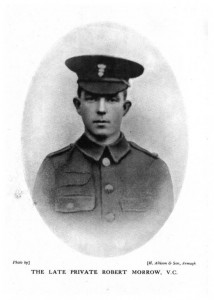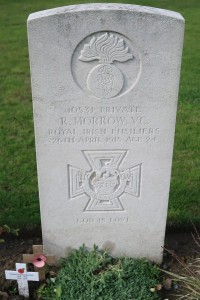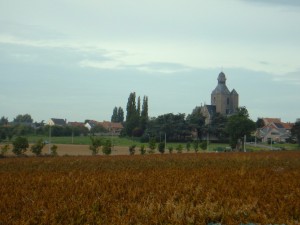
Private Robert Morrow VC
1st Battalion Royal Irish Fusiliers
(Royal Irish Virtual Military Gallery)
Near Messines, Belgium: Action of 12 April 1915
GOD IS LOVE
For most conspicuous bravery near Messines on 12th April, 1915, when he rescued and carried successively to places of comparative safety, several men who had been buried in the debris of trenches wrecked by shell fire.
Private Morrow carried out this gallant work on his own initiative, and under very heavy fire from the enemy.
In 2016 our visit to Mesen (Messines) was made on bicycle leaving Ieper (Ypres) at the start of the day, heading south to Ploegsteert. We would work our way back to Ieper taking a wandering path down roads and country lanes. Apart from walking the Western Front, the pedaled two-wheel frame helps one feel each rise in elevation. Each landscape offers something new. The clicking of the shutter does not instantly reveal how these pictures will be used and some time may pass, sometimes years, before we make a connection. And so, it was not until 2017 when on our arrival to the Salient that Chris and I chose to walk through the late afternoon and came across White House Cemetery where Robert Morrow rests. Morrow survived the Victoria Cross action but was mortally wounded at St. Julien 25 April 1915 and died the following day. Once again an example of finding connection across the Western Front on bike, on foot – the fields of battle – the fields of rest.

Morrow marker at White House Cemetery, Belgium. Age 24.
(P. Ferguson image, September 2017)
Helpful Link
Royal Irish – The Irish Soldier in the British Army

Looking towards Messines.
(P. Ferguson image, September 2016)
Tags: 12 April 1915, 26 April 1915, Messines, Posthumous Victoria Cross, Robert Morrow VC, Royal Irish Rifles, St. Julien (Belgium), White House Cemetery
This entry was posted by pferguson
on Wednesday, November 2nd, 2022 at 5:08 am and is filed under November Series, Remember Them Well.
You can follow any responses to this entry through the RSS 2.0 feed.
You can leave a response, or trackback from your own site.
About The Author

Paul has worked with the Paradigm Motion Picture Company since 2009 as producer, historian and research specialist. Paul first met Casey and Ian WIlliams of Paradigm in April 2007 at Ieper (Ypres), Belgium when ceremonies were being held for the re-dedication of the Vimy Memorial, France.
Paul's sensitivity to film was developed at an early age seeing his first films at RCAF Zweibrucken, Germany and Sardinia. Paul returned to Canada in 1967 and was captivated by David Lean's "Lawrence of Arabia" and "Bridge on the River Kwai". Over time Paul became increasingly interested in storytelling, content development, character, direction, cinematography, narration and soundtracks.
At the University of Victoria, Paul studied and compared Japanese and Australian film and became interested in Australian film maker Peter Weir and his film "Gallipoli" (1981). Paul was inspired when he learned Weir visited the beaches, ridges and ravines of the peninsula. "Gallipoli", the film, led Paul on many journeys to sites of conflict in England, France, Belgium, Holland, Germany, Malta, Hawaii, Gallipoli, North Macedonia and Salonika.
When Paul first watched documentary filmmaker Ken Burns, "The Civil War", Paul understood how his own experience and insight could be effective and perhaps influential in film-making. Combining his knowledge of Museums and Archives, exhibitions and idea strategies with his film interests was a natural progression.
Paul thinks like a film-maker. His passion for history and storytelling brings to Paradigm an eye (and ear) to the keen and sensitive interests of; content development, the understanding of successful and relational use of collections, imagery and voice. Like Paul's favorite actor, Peter O'Toole, Paul believes in the adage “To deepen not broaden.”
While on this path Paul always remembers his grandmother whose father did not return from the Great War and how his loss shaped her life and how her experience continues to guide him.




Comments